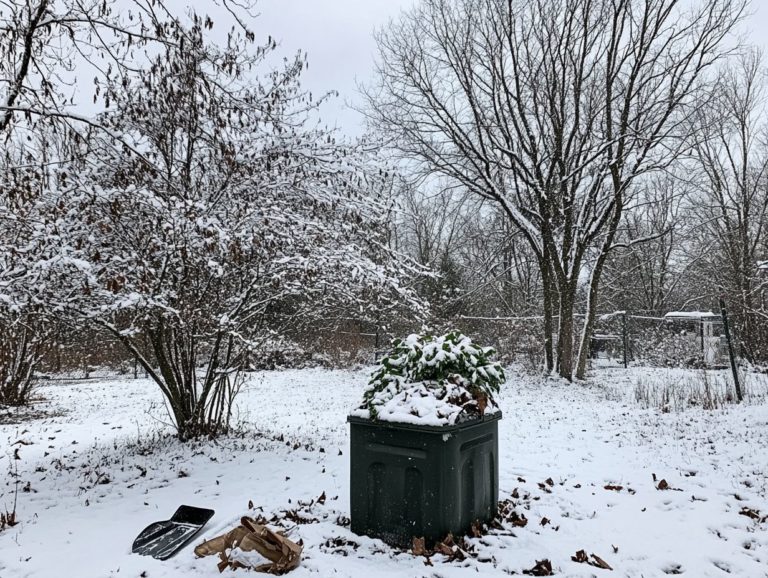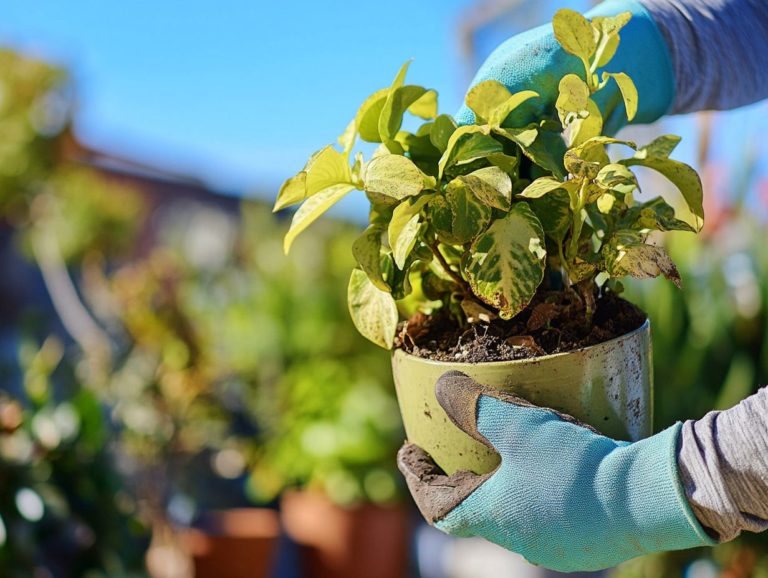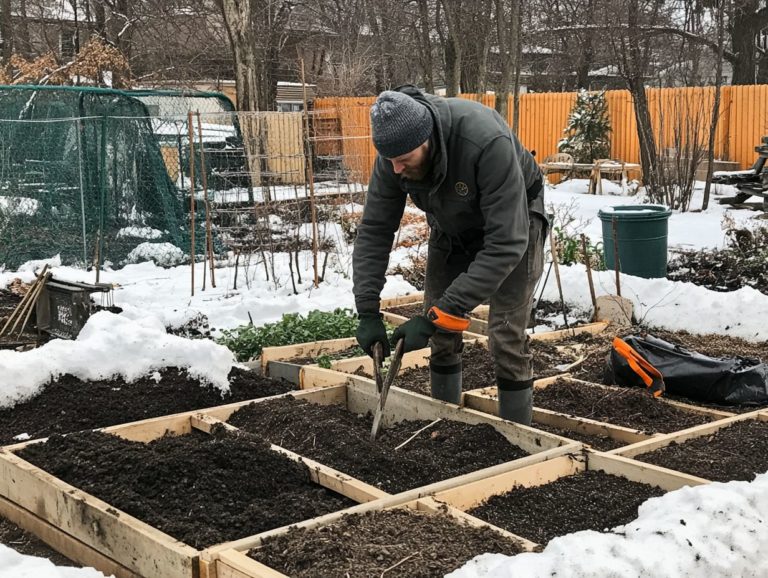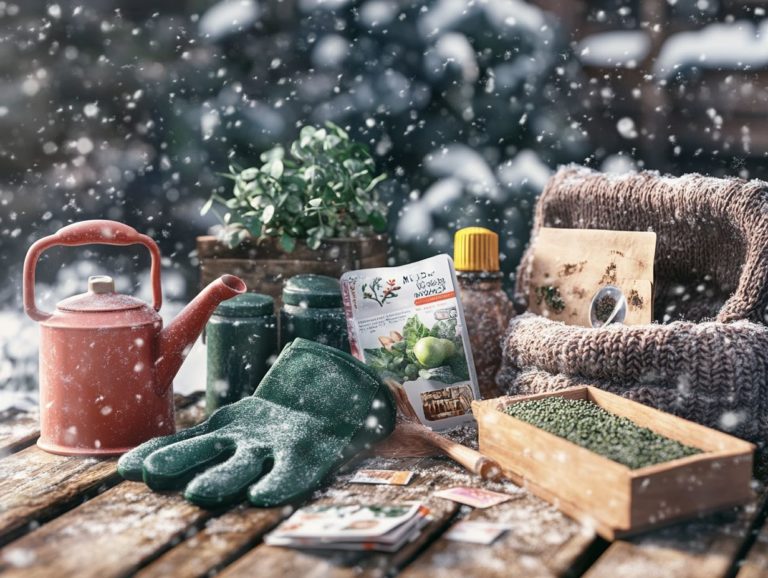Tips for Sustainable Winter Gardening
Winter gardening presents a remarkable opportunity for you to cultivate both beauty and bounty during the colder months, transforming a seemingly barren landscape into a thriving oasis.
This exploration delves into the benefits of winter gardening, highlighting its positive impact on both the environment and your gardening experience. You ll learn how to prepare your garden for the chill and select resilient plants that thrive even in low temperatures.
We will share strategies for protecting your plants from harsh weather, maintaining your garden, and harvesting delightful winter produce. Embrace the season and keep your green thumb active all year round!
Contents
Key Takeaways:
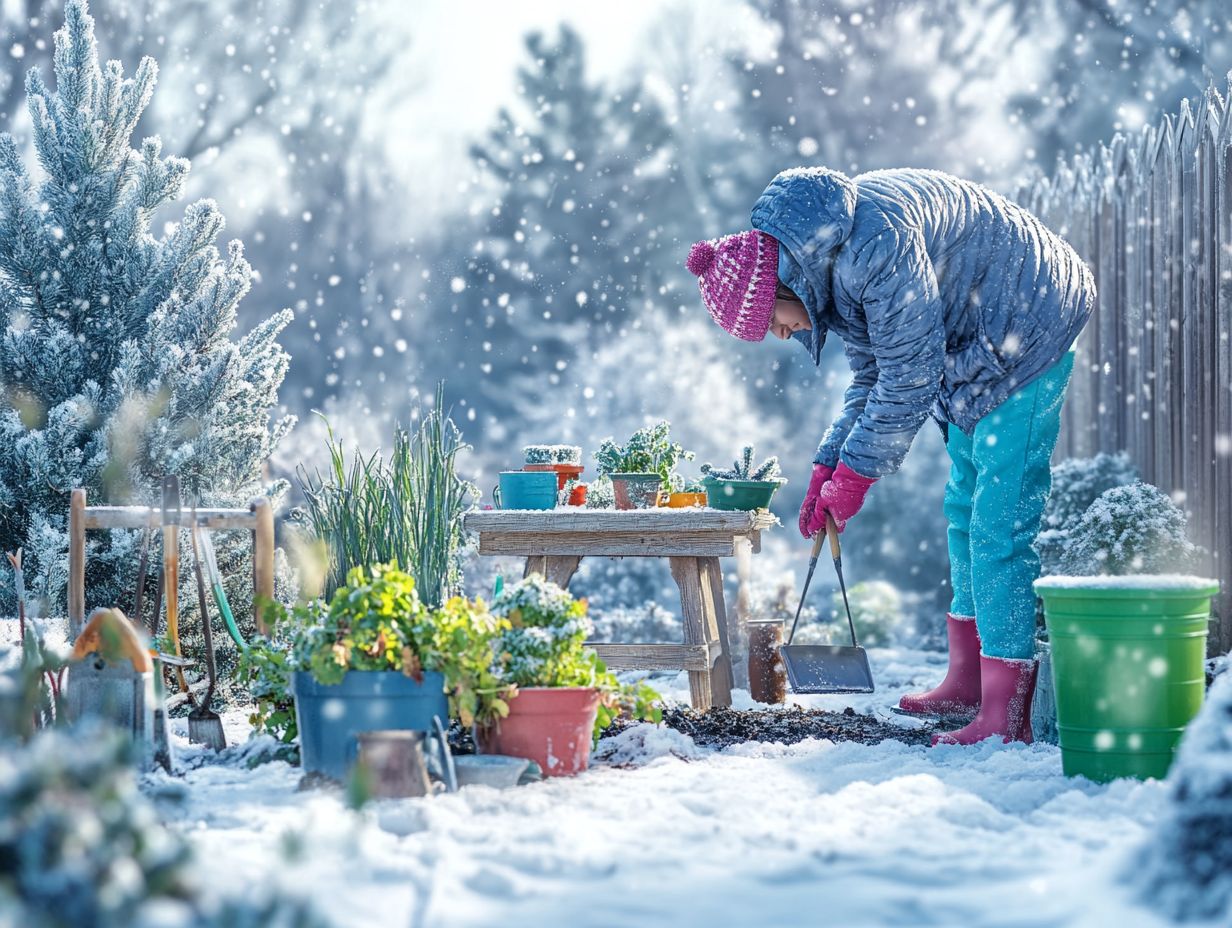
- Embrace winter gardening to reap benefits for both yourself and the environment!
- Prepare your garden and choose winter-friendly plants for a successful and sustainable winter garden!
- Protect your winter garden from harsh weather and maintain it regularly for a bountiful harvest of winter produce!
What is Winter Gardening?
Winter gardening involves growing plants, especially vegetables, during the chilly months using innovative techniques like cold frames a type of sheltered gardening structure and hoop houses, which are simple greenhouses that help extend your growing season. This approach allows you to cultivate hardy crops such as carrots, spinach, and kale even when temperatures drop.
Not only does this promote sustainability, but it also provides you with fresh organic produce throughout winter. To succeed in winter gardening, consider using aquaponics for winter gardening to master the art of protecting your plants from frost and harsh weather conditions.
By using strategies like mulching and fabric row covers, you can create a microclimate that nurtures growth while shielding your plants from extreme cold.
The advantages of winter gardening go beyond simply having access to fresh vegetables; it reduces your reliance on store-bought produce, lowers your carbon footprint, and offers the rewarding experience of nurturing life through even the harshest months.
Incorporating cover crops such as clover or rye can further enhance your soil health, preventing erosion and enriching nutrients for the upcoming growing season. This thoughtful approach emphasizes the importance of winter gardening in promoting organic practices and fostering resilience in our food systems.
Benefits of Winter Gardening
Winter gardening offers a wealth of advantages, allowing you to harvest fresh vegetables even in the chill of the season. This not only boosts your nutritional options but also fosters sustainability by minimizing food miles and reducing dependence on imported produce.
As you explore winter gardening, you’ll discover eco-friendly practices that enhance soil health and promote biodiversity. This pursuit transforms into a gratifying experience for both you and the environment!
Advantages for the Environment and Gardener
Engaging in winter gardening not only gifts you with fresh vegetables during the off-season but also brings a wealth of environmental benefits, such as enhanced soil health, reduced erosion, and increased biodiversity that supports local ecosystems. To make the most of your winter gardening experience, consider using the top 10 must-have tools for winter gardening. By embracing sustainable practices, you significantly contribute to conservation efforts while relishing the rewards of your labor, even in the colder months.
This gardening method enriches the soil through natural mulching, which effectively locks in moisture and nutrients, fostering a nurturing environment for microorganisms. Your winter crops act as protective covers, shielding the soil from biting winter winds, thereby preventing erosion and nutrient leaching.
By introducing various winter plants, you enhance biodiversity, providing habitats for beneficial insects and pollinators, nurturing an interconnected ecosystem.
By opting for organic methods like companion planting and crop rotation, you create a balanced ecosystem that boosts your harvest while nurturing the broader environmental landscape, ultimately contributing to a healthier planet.
Preparing Your Garden for Winter
Preparing your garden for winter is essential for the success of your winter gardening efforts. You ll want to tackle specific tasks like composting, applying mulch, and conducting soil tests to enrich both the fertility and structure of your soil.
This thoughtful preparation will set the stage for a bountiful winter harvest when the growing season returns!
Essential Tasks for Winter Gardening
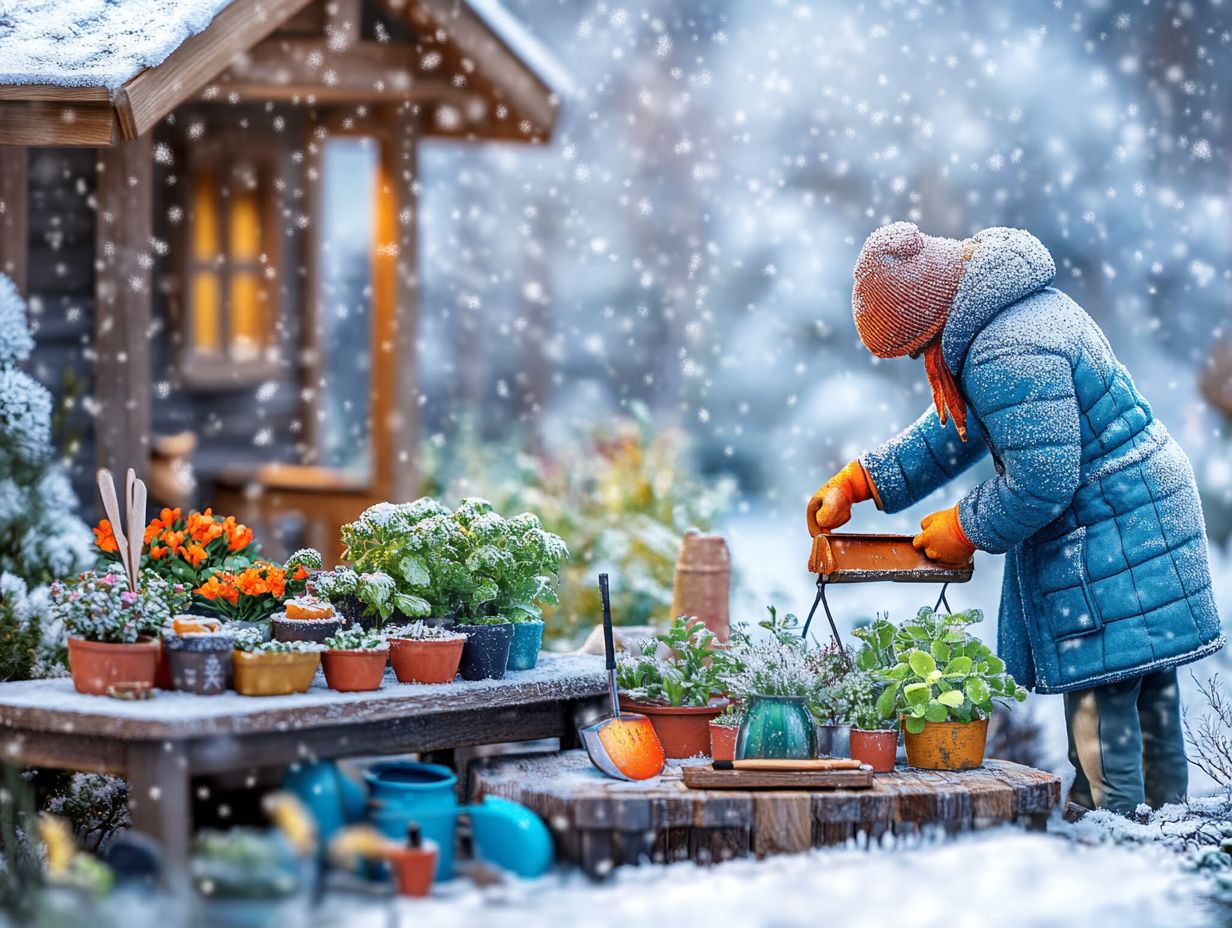
Key tasks for successful winter gardening involve implementing essential planting tips and sustainable practices to protect your crops. For more information, consider the best practices for winter gardening, such as utilizing row covers and frost protection techniques to help shield your delicate plants from harsh weather.
By staying diligent with these tasks, you can significantly enhance your chances of a bountiful winter harvest while maintaining the integrity of your garden beds throughout the coldest months.
To ensure thriving plants, select cold-hardy varieties that can withstand lower temperatures, such as kale and carrots. These crops not only thrive in cold but also provide excellent nutritional value.
Mulching plays a vital role as well; it insulates the soil and retains moisture, promoting healthy growth.
Applying floating row covers can create a small area with different weather conditions than the surrounding area, protecting your plants from frost while allowing sunlight to reach them. Regular maintenance, including monitoring soil moisture and removing any dead foliage, will foster a healthier environment for your winter crops. By effectively implementing these strategies, you’ll set yourself up for a successful gardening experience, even amid frigid conditions.
Choosing Winter-Friendly Plants
Selecting the right winter-friendly plants is crucial for your winter garden’s success. Focus on hardy crops like spinach, kale, and carrots that thrive in colder temperatures, offering nutritional value throughout the season.
By choosing these resilient varieties, you can truly maximize your winter gardening efforts and savor a diverse harvest of fresh vegetables, even during the harshest months!
Types of Plants that Thrive in Winter
Various types of plants flourish in winter, including crops such as spinach, kale, carrots, and brassicas. These hardy varieties are perfectly suited for cold climates and can thrive in your vegetable garden with the right techniques and care.
Take spinach, for example. It’s known for its rapid growth and impressive frost tolerance, making it an ideal choice for winter plantings. Kale, boasting a rich nutrient profile, thrives in cold weather and can even become sweeter after a frost, enhancing its flavor.
Root vegetables like carrots can be left in the ground to harvest later, allowing you to enjoy fresh produce even in the depths of winter. Meanwhile, brassicas, including broccoli and cabbage, are equally resilient and thrive in cooler temperatures.
By focusing on these crops, you not only maximize your harvests but also promote biodiversity and improve soil health throughout the off-season.
Protecting Your Garden from Harsh Weather
To guarantee the success of your winter gardening efforts, safeguarding your garden from the harsh elements is essential. Employ techniques like cloches, row covers, and cold frames to offer frost protection for your delicate plants.
These protective measures do more than just shield your crops from extreme temperatures; they also help create a favorable environment, enabling your plants to flourish even in the chill of winter.
Start preparing your garden today for a thriving winter harvest!
Strategies for Keeping Plants Safe
Implementing effective strategies to keep your plants safe during winter is essential. Consider using hoop houses, cold frames, and row covers to shield them from frost and extreme weather.
These techniques not only bolster resilience but also optimize growth potential. For a deeper understanding, check out the top 5 challenges in winter gardening, ensuring your winter gardening experience is productive.
By utilizing these protective measures, you can improve keeping the right temperature and moisture retention critical factors for plant health during the colder months.
Cold frames create a cozy microclimate, offering warmth and protection. Hoop houses can be designed for larger areas, providing shelter for a variety of crops. Row covers serve as a barrier against biting cold winds and pesky pests, creating a safer haven for your delicate seedlings.
Each of these methods plays a unique role in safeguarding your plants, ultimately leading to healthier, more robust growth, even in the face of harsh winter conditions.
Maintaining Your Winter Garden
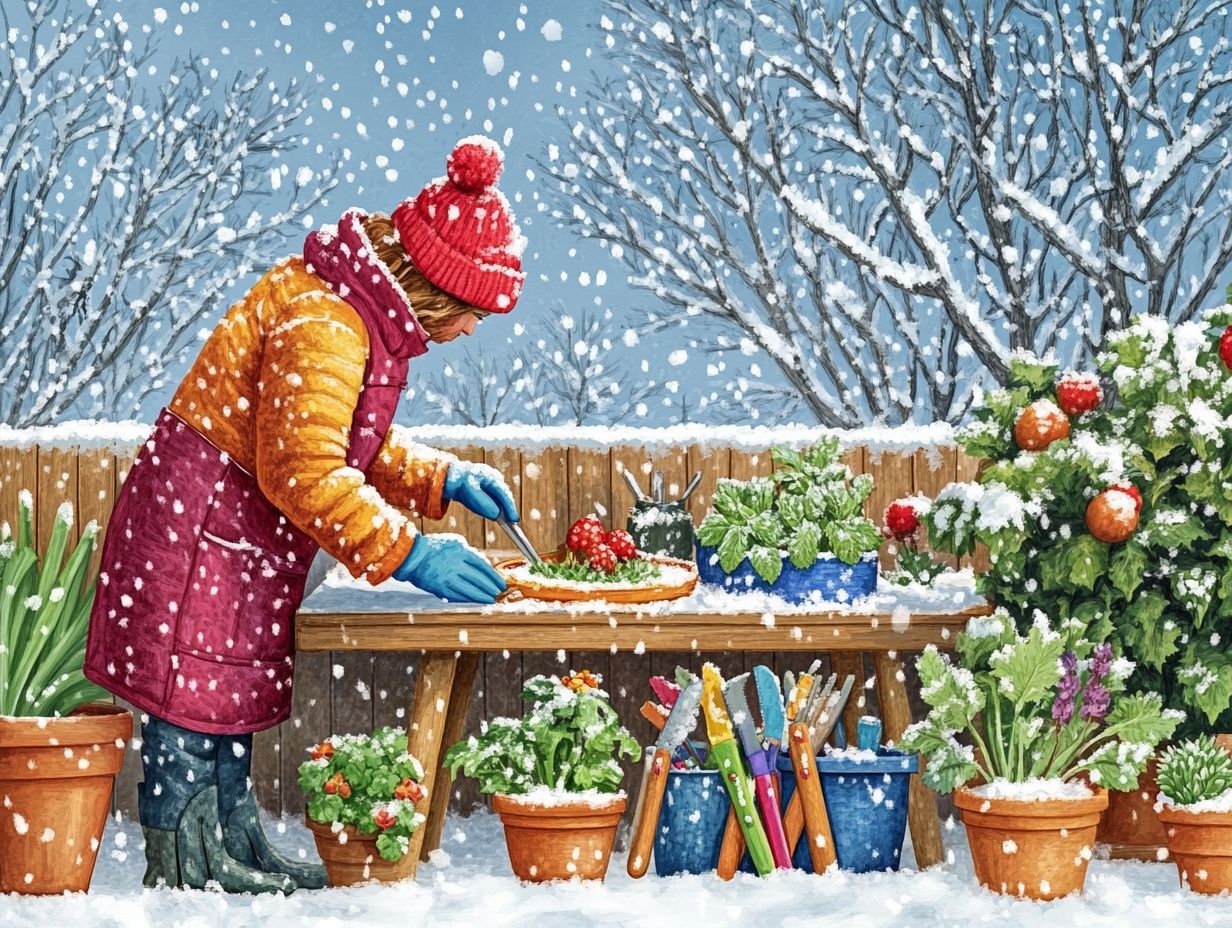
Maintaining your winter garden demands a dedicated approach to regular tasks that nurture the health and productivity of your plants. This commitment may involve composting, precise watering, and vigilant monitoring of soil conditions to foster optimal growth.
By adhering to tailored maintenance tips, such as tips for using greenhouses in winter gardening, you can cultivate a resilient environment that not only supports your winter crops but also elevates the sustainability of your gardening practices.
Regular Tasks and Maintenance Tips
Regular tasks and maintenance tips are essential for achieving a successful winter garden. Engaging in composting to enrich your soil, employing proper watering techniques to prevent over-saturation, and conducting regular checks on plant health are crucial. Additionally, consider utilizing vertical gardening in winter to maximize your space and enhance growth.
By adopting eco-friendly practices during these maintenance tasks, you further support sustainable gardening efforts and enhance the overall growth potential of your winter crops, such as with top tips for growing kale in cold climates.
Mulching is another vital practice to incorporate. This technique retains soil moisture, suppresses weeds, and protects plant roots against harsh winter temperatures. Use natural materials like straw, leaves, or wood chips, as they improve soil health through decomposition.
Implementing crop rotation in your winter garden helps prevent disease buildup and nutrient depletion. Regularly testing the soil pH helps you understand necessary amendments to optimize conditions for your winter vegetables.
By embracing these eco-friendly strategies, you will cultivate thriving plants while contributing to a healthier ecosystem.
Harvesting Winter Produce
Harvesting winter produce is an exciting challenge that can reward you with incredible flavors! It demands a nuanced understanding of best practices to elevate the quality and flavor of crops like spinach, kale, and carrots, which often develop a richer taste after frost exposure.
By mastering the right techniques and timing for winter crops, you can optimize your vegetable harvest and truly relish the rewards of your winter garden.
Best Practices for Harvesting in Winter
Implementing best practices for winter harvesting means timing your harvest perfectly to attain peak flavor and quality. For crops like spinach, carrots, and kale, waiting until after a frost can significantly enhance their sweetness.
Mastering the right techniques boosts your yield and supports your ongoing organic gardening efforts.
To achieve the best results, it s essential to keep an eye on weather patterns and soil temperatures. This ensures you harvest just after a frost when those sugars have reached their concentration peak. Using a soil thermometer can be a game-changer for timing; typically, the ideal moment for harvesting is mid-morning, when the sun has warmed the plants, making them more manageable.
Employing mulching techniques can also shield your crops from harsh cold while extending your harvest season. By following these strategies, you can maximize the quality of your winter produce, enhancing both taste and nutritional value.
Frequently Asked Questions
Got questions about winter gardening? Here are some common inquiries to help you out!
What is sustainable winter gardening?
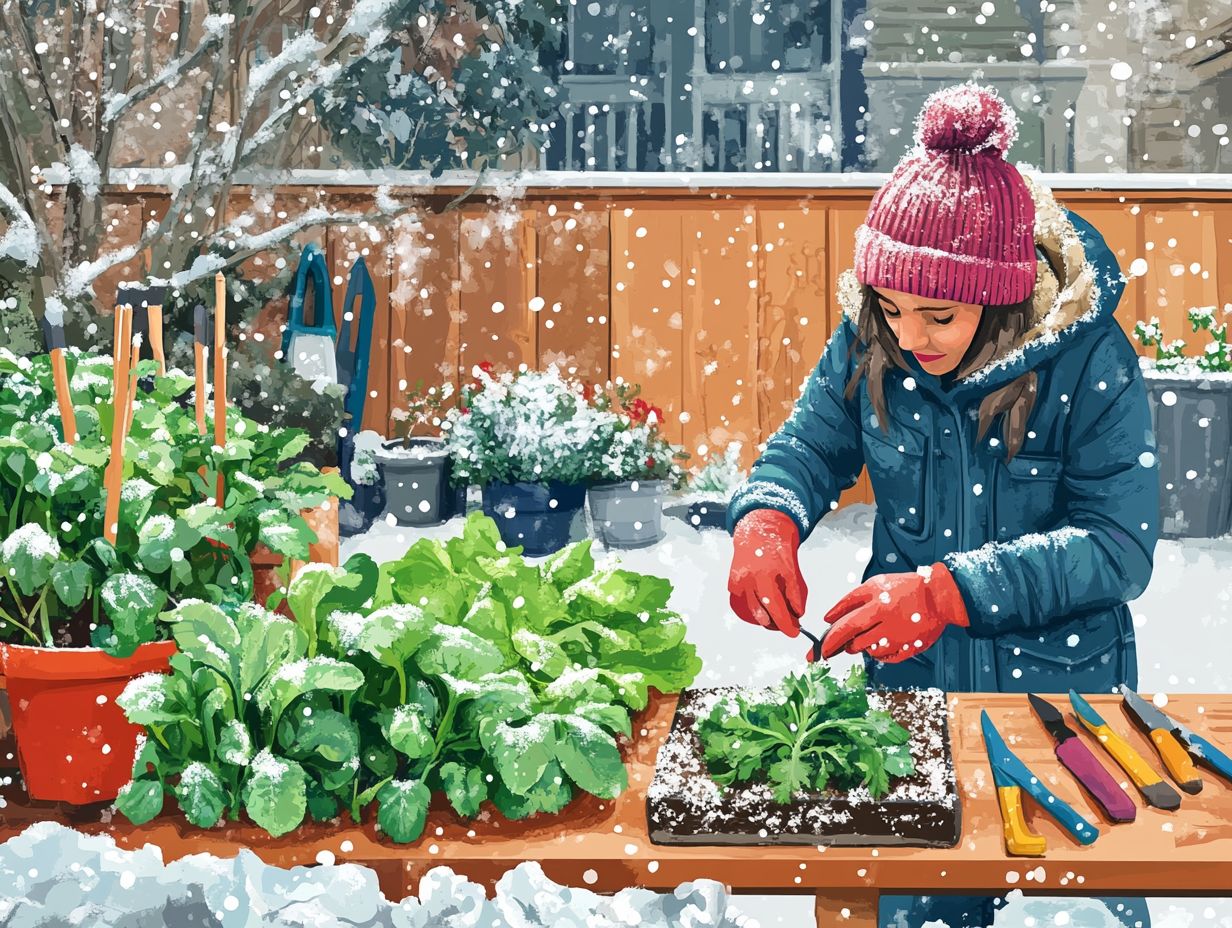
Sustainable winter gardening is the practice of growing plants in winter. For those interested, winter gardening tips for enthusiasts can help minimize environmental impact and conserve resources.
Why is this practice important?
Sustainable winter gardening enables year-round food production. To enhance your efforts, consider exploring the best cold-weather gardening techniques, which also reduce the need for transporting produce and promote biodiversity.
What are some tips for winter gardening?
Consider using organic and natural fertilizers. Choose cold-hardy plants, conserve water with mulch, and rotate crops to keep the soil healthy.
Can I use my existing garden for winter gardening?
Yes, you can use your existing garden! Prepare the soil in the fall, protect plants from frost, and use cover crops to enrich the soil.
Are there benefits to winter gardening?
You can enjoy fresh produce all winter long! It also helps reduce your carbon footprint and boosts your garden’s health.
Do I need special equipment for winter gardening?
You don t need special tools to get started. A greenhouse or cold frame can help, but they aren t necessary for success.

